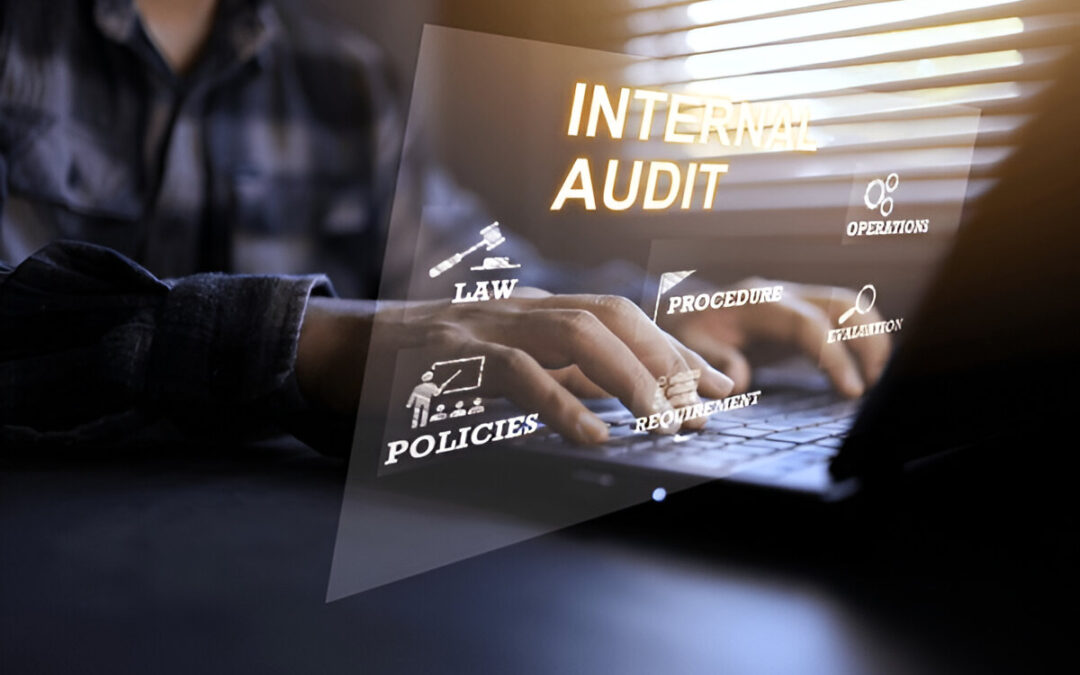Do you mix up internal audit and compliance in IT? If so, you’re not alone. After all, both processes are designed to make sure that rules are followed. However, they’re not exactly the same. This leads to the question: How does the internal audit vs compliance conundrum stack up?
The short answer is that internal audits check if your IT controls and processes actually work and help your business meet its goals. Compliance, on the other hand, makes sure your organization adheres to external industry laws and regulations.
If your company handles customer data or deals with privacy rules, knowing the difference between internal audits and compliance matters a lot.
Read on for a deeper dive into this topic.
Fundamentals of Internal Audit and Compliance in IT
In IT, both internal audit and compliance hold significant importance. Each one helps your organization’s technology systems follow the right rules and best practices. However, their focus and methods aren’t quite the same.
Defining Internal Audit in IT
Internal audit in IT works as an independent function. It takes a close look at how well your IT systems are managed, providing an understanding of the organization’s operations — if the controls, systems, and procedures work, spot problems, and suggest improvements.
Auditors often review every part of your IT environment. They look at data protection, access management, and whether internal policies are actually followed. This helps them test for weaknesses, spot risks, and suggest corrective actions.
Defining Compliance in IT
Compliance teams focus on figuring out which regulations your company must follow—like cybersecurity or privacy laws—and making sure daily operations meet relevant laws. This usually includes rules around data privacy, industry standards, and security requirements.
If you manage IT, you’ll work with compliance teams to track changes in regulations and keep things up to date.
A compliance officer or team helps your organization stay within the applicable law and with specific compliance requirements. They develop policies, train staff, and prep for external audits.
Relationship Between Internal Audit and Compliance
You’ll see some overlap between an internal audit and a compliance audit, but they have distinct roles. Internal audit provides independent checks of how well your compliance function actually works. It’s not just about following rules on paper, but in practice too.
Internal audit is broader and covers all parts of IT, while compliance usually has a narrower primary focus.
Compliance sets the foundation by identifying the established standards, rules, and regulations your organization must follow. Internal auditors test whether these measures actually work.
Both groups report to senior management and play a role in governance, risk management, and ethics.
Relationship highlights:
- Compliance builds rules; internal audit checks they’re followed
- Internal audits deliver findings and actionable recommendations; compliance ensures ongoing adherence
Key Differences: Internal Audit vs Compliance in IT
Internal audit and compliance have different but important jobs in IT. It’s crucial to know which does what, as it can help you make better decisions.
The table below highlights the major differences between internal audit and compliance:
| Aspect | Internal Audits | Compliance |
| Purpose & Scope | Internal audits take an in-depth, objective look at whether IT controls and processes are working. They’re looking for potential risks or gaps that could put your systems or data at risk. | Compliance is all about making sure your organization follows the rules. This could be privacy laws, data security standards, or other industry regulations you need to stick to. |
| Approach & Methodology | Internal auditors focus on the biggest risks. They use a risk-based approach to test different parts of your system and document their findings to share with leadership. | Compliance checks off the boxes. They use checklists and monitoring tools to keep track of whether everything is in line with the rules. It’s about consistent monitoring and reporting. |
| Roles & Responsibilities | Internal auditors don’t manage day-to-day operations. Instead, they evaluate and assess how well your IT systems are working, identifying any risks or inefficiencies. | Compliance staff make sure your operations align with laws and industry standards. They create the policies and keep track of whether everyone is following them properly. |
| Reporting & Accountability | Internal audit reports are formal and in-depth. They share findings and make suggestions for improvement with senior management or the audit committee. | Compliance teams keep you informed with regular updates and reports. They track whether tasks are getting done and whether there are any violations. Their accountability is based on following the rules. |
Regulatory Frameworks and IT Compliance Requirements
Modern IT systems need to meet a multitude of complex regulations and standards. This means your organization needs to stay on top of these legal obligations to stay effective and trusted while managing risks around cybersecurity and data protection.
Regulatory Compliance and Standards
IT regulatory compliance refers to following all the laws and recognized standards in your industry. These include standards such as HIPAA, GDPR, and PCI DSS.
Cybersecurity frameworks, like NIST and ISO/IEC 27001, help you organize security controls and protect sensitive data. Each standard lays out specific rules your organization must follow.
If you don’t meet these requirements, you could face legal trouble, fines, or damage to your reputation. Some sectors, like finance and healthcare, have extra rules because their data is so sensitive.
It is important to stay on top of regulatory updates, since digital threats and laws change all the time.
Policies, Procedures, and Compliance Programs
Having solid internal policies and procedures helps to comply with industry regulations. These policies define system access, data usage, and how threats are handled.
Your compliance program should include:
- Documented policies
- Standard operating procedures
- Employee training and awareness initiatives
- Clear reporting structures
- Regular reviews and updates to procedures
This commitment to compliance should be visible at every level of your organization.
IT Compliance Audits and Reviews
Compliance audits are formal reviews that check if your organization follows rules and regulatory requirements. These audits can be internal or done by outside third parties.
Internal audits come from your own team, while external ones might be required by law or contracts. Auditors may review policies, interview staff, and check how well your security controls actually work.
They’ll look at real examples, like your access control or whether data backup meets regulatory standards. Clear evidence—like logs, reports, and training records—matters for passing these reviews.
Handling Compliance Risks and Issues
You need to spot, assess, and respond to compliance risks to avoid trouble. This means:
- Watching for new or changing laws and regulations
- Reviewing how cyber threats might harm your business operations
- Checking for third-party risks
If you find compliance issues or violations, you need to act fast to fix them. This could mean retraining employees, updating policies, or tightening controls.
At the end of the day, the goal is to reduce risks and stop errors from being repeated. Every compliance audit or review is a chance to learn and improve your program and show your commitment to complying with regulations.
Impact on IT Governance, Risk Management, and Operational Effectiveness
When it comes to IT governance, internal audit and compliance shape risk management, oversight, and how smoothly your organization runs. Understanding their differences and responsibilities can help your team keep operations secure and meet important standards.
Role in Risk Management and Internal Controls
Internal audit teams check that your risk management processes and internal controls actually work. They use risk assessments to spot weaknesses and review how effective your controls are for things like anti-money laundering, cyber security, and third-party vendors.
Compliance pays close attention to laws and industry guidelines, like those from the American Institute of Certified Public Accountants (AICPA). Their checks help make sure your operational and financial activities meet specific regulatory rules.
Certified internal auditors and Certified public accountants know how to give unbiased reviews. Compliance staff often stick to checklists and set procedures.
Internal auditors also suggest practical recommendations. This helps you address the findings of an audit and improve efficiency and effectiveness on a broader scale.
Oversight, Accountability, and Reporting
The audit committee and external auditor review audit findings and compliance reports. They hold the organization accountable.
Internal audit gives independent assurance to the board and senior management about controls, risks, and financial and operational issues. Compliance reports to management on whether the organization follows required standards.
This group may also update you about changes in regulations or industry best practices, especially around anti-money laundering and cyber security. You should review and act on reports from both areas.
Internal audit delivers insights and actionable feedback. Compliance often uses pass/fail results.
Technological and Operational Considerations
Both internal audit and compliance shape your organization’s technology and daily operations. Internal auditors examine IT systems to make sure they’re secure, reliable, and capable of supporting business goals.
They look for weaknesses in your IT governance structure that could limit your operations. Compliance teams check if IT processes meet external standards, like data privacy or sector regulations.
They make sure your systems are designed to prevent and detect problems before they hit your business. For the best results, these groups need to coordinate.
This teamwork helps you achieve effective IT controls and operational effectiveness through a structured approach. Their work ensures your technology supports both risk and compliance goals, without extra delays or costs.
Frequently Asked Questions
Q. What are the primary responsibilities of internal audit compared to compliance in IT?
An internal audit reviews controls, processes, and risk management in IT systems to find weaknesses and suggest improvements. In contrast, compliance ensures your organization meets legal and regulatory IT requirements.
Q. How does the scope of work differ between internal audit and compliance teams?
The former looks at all parts of your IT operations. It can review anything from data security to system backups to check how well your processes work. The latter has a narrower scope and checks if your IT processes follow specific regulations like GDPR or PCI DSS.
Q. What qualifications do professionals typically need in IT compliance and internal auditing?
IT internal auditors usually need certifications like Certified Information Systems Auditor (CISA) or Certified Internal Auditor (CIA). Compliance professionals often have certifications such as Certified Information Systems Security Professional (CISSP) or Certified in Risk and Information Systems Control (CRISC).
Q. How do the frequency and process differ between compliance reviews and internal audits?
Internal audits usually follow a set schedule, like quarterly or yearly reviews. Sometimes, they are performed when new systems launch or after a security event. Compliance reviews may happen more often, especially if you work in a highly regulated industry.
Q. How do internal audit findings influence compliance strategies within an IT organization?
Your internal audit team might spot new risks, gaps, or ways to improve controls that compliance didn’t catch. These findings can lead you to update your policies or training.
Q. Can you explain the typical career progression for individuals in IT internal audit versus compliance roles?
If you work in internal audit, you might start as a junior auditor. Over time, you could move up to senior or lead auditor. Some folks eventually become audit managers or even chief audit executives.
In compliance, you could begin as an analyst or officer. Later, you might step into a compliance manager role. You may even end up leading the compliance department as a director or chief compliance officer.
Final Thoughts
Understanding the difference between an internal audit and compliance in IT is key to keeping your systems running smoothly and securely. Internal audits focus on checking if your controls are working as they should, while compliance ensures you’re following the rules. Both are necessary, but they each play a different role.
Knowing when to use each can make all the difference in managing risks and avoiding costly mistakes. Get the right support, and your IT systems will not only be safe—they’ll help your business thrive.
Need Expert Help? Crown Computers Has You Covered
Don’t leave your IT systems to chance. At Crown Computers, we specialize in making sure your business is secure, compliant, and ready for the future. Our team can handle your internal audits, compliance needs, and more. Reach out to us today, and let’s get your IT on the right track!
Call us or send us an email to get in touch.


